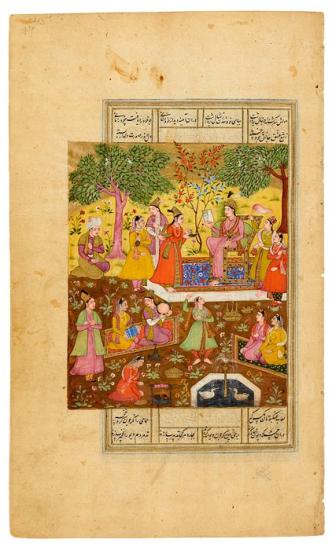
Shīrīn, an Armenian Princess, Looks at a Portrait of Khusrau
Khamsa (Quintet), in Persian, written by Mullā Fatḥ Muḥammad
Purchased by Pierpont Morgan, 1910
Khusrau, in a dream, learned from his grandfather that he was destined to have Shabdīz, the world's swiftest steed, and Shīrīn, an Armenian princess whose sweetness and beauty would sustain him for as long as he lived. Khusrau's dearest friend was Shāpūr, a painter whose portraits captured both the likeness and the soul of the subject. As it happened, Shāpūr had seen Shīrīn on a trip to Armenia, and he was now sent to find her on Khusrau's behalf. In Armenia, Shāpūr sketched a portrait of Khusrau and hung it on a tree in a meadow frequented by Shīrīn, hoping she would discover it. Shīrīn had a handmaiden bring the portrait of the handsome man to her, but fearing it was the work of evil spirits, had it destroyed. The next morning Shāpūr hung a second portrait on a tree, but Shīrīn's maid refused to fetch it. The third morning, in another meadow, Shāpūr hung a third portrait. This time, overcome with love, Shīrīn herself took it from the branch. In the miniature Shīrīn holds the magic portrait in her hands and is transfixed by the handsome prince, wondering who he was. Eventually Shāpūr, seated at the far left, tells her about Khusrau's dream of their destined love.
This episode appears in Khusrau va Shīrīn (1180), the second story in Niẓāmī's Khamsa (Quintet).
Persian poetry
The Persians loved their poetry and their poets, though the Qur˒an warned against believing their words (sura 69.41) and "those straying in evil who follow them" (sura 26.224). While Arabic was the first language of Islam and the language of the Qur˒an, Persian was favored by poets. Even Firdausī's (940–1020) celebrated Shāhnāma (Book of Kings), the national epic of Persian, was written in verse—some 50,000 couplets! Rūmī (1207–1273), the best known of the Sufi poets, put poetry in perspective when he wrote, "A hundred thousand books of poetry existed / Before the word of the illiterate [Prophet] they were put to shame!" (Masnavī I, 529). Presented here are illustrations of Firdausī's Shāhnāma as well as works by Sa˓ dī (ca.1184–1292), Hāfiz (ca. 1320–1389), and Jāmī (1414–1492), regarded as the last of the great Sufi poets. Also featured are illustrations from each of the five poems of the Khamsa (Quintet), by Niẓāmī (ca. 1141–1209), especially Lailā and Majnūn (The Persian Romeo and Juliet) and Bahrām Gūr's Seven Princesses.
